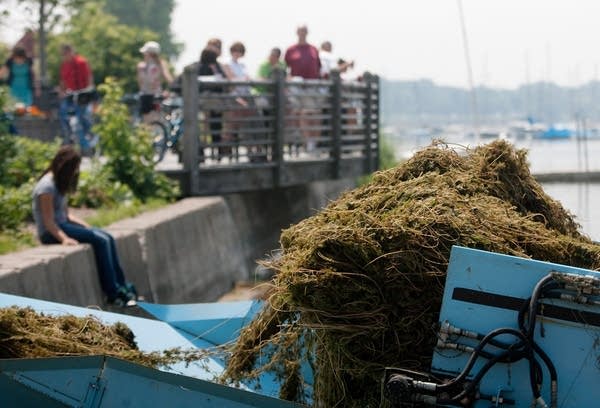Weeds clog Minnesota lakes earlier this year
Go Deeper.
Create an account or log in to save stories.
Like this?
Thanks for liking this story! We have added it to a list of your favorite stories.

The weeds on Lake Calhoun have grown so thick this year that it almost looks as if the Minneapolis lake has islands.
Much of it is Eurasian watermilfoil, an invasive species that has taken over in most lakes in the Twin Cities and elsewhere throughout the state. The milfoil has become a common sight, but this year's warm spring means it has hit its peak earlier than usual.
The weeds tickle swimmers' legs and feet and make it harder for boats -- especially sailboats -- to navigate the lake without getting stuck.
"It's just gotten progressively worse, and this is the worst year we've had," said Mike Elson, who leads the Calhoun Yacht Club and has been sailing on Lake Calhoun since 1979.
Turn Up Your Support
MPR News helps you turn down the noise and build shared understanding. Turn up your support for this public resource and keep trusted journalism accessible to all.
Elson said sailboats are now unable to use about a third of the lake because the weeds are so thick in some areas. The weeds are especially bad in an area where sailboats are tied to buoys, making it difficult for sailboats to get in and out.
The Minneapolis Park and Recreation Board has a machine that can harvest milfoil from the water's surface down about four feet, and they began using it on Lake Calhoun on Thursday.

But cutting the milfoil is a time-consuming process, and the weeds grow back. In addition, the Minnesota Department of Natural Resources requires some of the milfoil to be left alone because it's become fish habitat.
"Overly aggressive control can do more harm than good, said Chip Welling, who coordinates the milfoil control program for the DNR.
Welling said the DNR's program is designed improve recreational access to milfoil-infested lakes without going too far.
"Cutting channels for sailboats is going to provide relief from a nuisance, but is not going to be so extensive as to affect the lake as a whole," he said.
Minneapolis is cutting back milfoil on four of its lakes this summer -- Cedar Lake, Lake Calhoun, Lake Harriet and Wirth Lake -- at a cost of about $100,000. Officials will let the weeds grow at Lake of the Isles this year, because the park system only has one machine and that lake is primarily used by canoes, which can usually get through the weeds.

Tim Brown, who manages environmental operations for the park system, said it's possible the milfoil will die back sooner than usual. He said while the lakes might not be the prettiest sight with all the weeds, the water itself is clear.
"Those aquatic plants indicate a healthy lake as opposed to a lake dominated by algae," Brown said.
On many lakes, the weeds have been around long enough that those who use them for recreation have gotten used to it.
"You end up just using what nature gives you -- it's the wind, it's the water, and sometimes it's the milfoil," said Clay Babcock, who sails on Lake Harriet and writes the "Cruising Lake Harriet" blog.
"I think they're doing a pretty good job of using fairly limited dollars," Babcock said of the efforts to cut the milfoil back. "But overall, you just wish it wasn't there."

And it's not like Babcock and others who sail can simply drive to another nearby lake: All of the major lakes in the Twin Cities area have milfoil.
Elson said the 150 boat buoys on Lake Calhoun have all be rented this year -- the first time in a while that that's happened.
"There seems to be more people coming to the lake," he said.
Welling, of the DNR, said not all lakes statewide are infested. He encouraged people to help prevent the spread.
"It's abundant and problematic in some lakes," he said. "People can reduce these problems by cleaning all vegetation from watercraft before they leave any lake or river."
Dear reader,
Your voice matters. And we want to hear it.
Will you help shape the future of Minnesota Public Radio by taking our short Listener Survey?
It only takes a few minutes, and your input helps us serve you better—whether it’s news, culture, or the conversations that matter most to Minnesotans.




